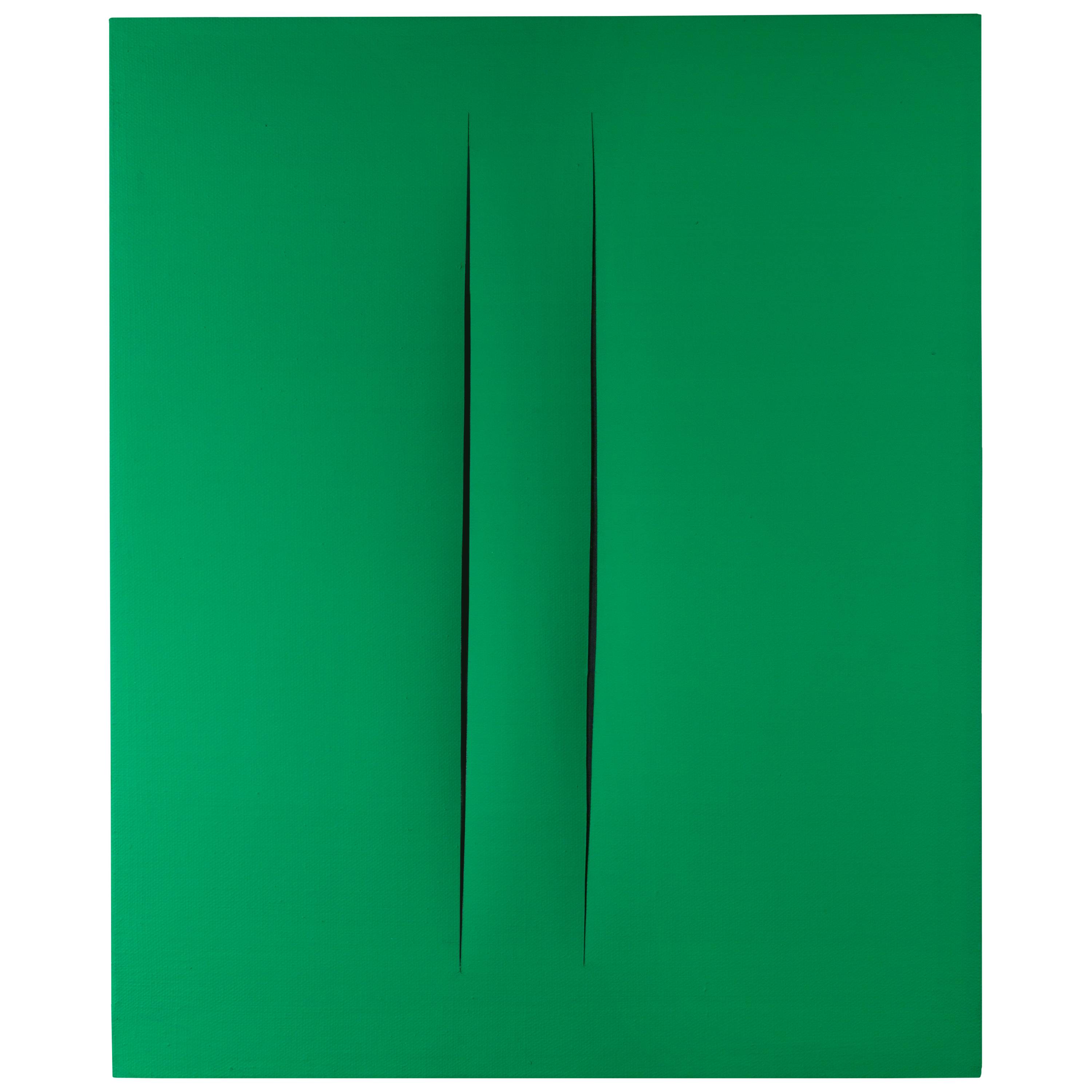- EN
Log in
- Live Auctions
- Past auctions
- More
- Gallery
- Art Dealing
- Publishing
- Kornfeld today
- The Story of Kornfeld
- Information
Note: The image cannot be displayed for legal reasons. For more information, see the PDF of the catalogue: Link to PDF
Rosario de Santa Fé 1899 - 1968 Comabbio
1964-1965
Dispersion paint on canvas
60,6x50 cm
Signed, titled and inscribed on the reverse by the artist in felt-tip pen "L. Fontana / Concetto Spaziale / ATTESE / Quando suonano gli / organi penso a / Varese"
Enrico Crispolti, Lucio Fontana, Catalogo ragionato di sculture, dipinti, ambientazioni, vol. II, Mailand 2006, cat. no. 64-65 T 47, reprod. pag. 554
Jiyugaoka Gallery, Tokyo
Yoshio Kojima Collection, Tokyo
Auction Sotheby's, London, 9.12.1999, cat. no. 388
Private collection, Monaco
Auction Christie's, London, 1.7.2009, cat. no. 163
International private collection
In perfect condition
With his "Manifesto bianco" published in 1946 and the manifestos of "Spazialismo" published in 1947, Fontana called for a departure from conventional materials in art. Art should no longer be static, but become dynamic. Initially, his newly defined spatial concept of art was based on perforated canvases, but from 1958 onwards a new dimension was added with the "tagli", the cuts in geometrically painted, later purely monochrome canvases. The artist cut through the painted/primed canvases from the front or back. Many works have one cut, some more than 10. The cuts, backed with gauze, virtually destroyed the picture support - and thus the "basis" of traditional painting itself, they "hurt" the work of art, but at the same time made it spatially dynamic
The canvases are mostly painted monochrome, which reinforces the "intervention". The black gauze behind the canvas creates an unbelievable effect of depth, which changes constantly as you look at it. The work offered here is characterised by two cuts into a green painted canvas. The parallelism of the two "tagli" appears balanced and composed. Is this why Fontana writes on the reverse "Quando suonano gli organi penso a Varese" (When they play organs, I think of Varese)? The "Concetto Spaziale" offered here is certainly one of the most attractive works with two incisions in the composition and fresh colours
1964-1965
Dispersionsfarbe auf Leinwand
60,6x50 cm
Rückseitig vom Künstler in Filzstift signiert, betitelt und bezeichnet "L. Fontana / Concetto Spaziale / ATTESE / Quando suonano gli / organi penso a / Varese"
Enrico Crispolti, Lucio Fontana, Catalogo ragionato di sculture, dipinti, ambientazioni, Bd. II, Mailand 2006, Kat. Nr. 64-65 T 47, reprod. pag. 554
Jiyugaoka Gallery, Tokyo
Slg. Yoshio Kojima, Tokyo
Auktion Sotheby's, London, 9.12.1999,
Privatsammlung, Monaco
Auktion Christie’s, London, 1.7.2009,
Internationale Privatsammlung
In tadellosem Zustand
Mit seinem 1946 publizierten "Manifesto bianco" und den 1947 publizierten Manifesten des "Spazialismo" forderte Fontana die Abkehr von herkömmlichen Materialien in der Kunst. Die Kunst sollte nicht mehr statisch sein, sondern dynamisch werden. Waren es zuerst mit Löchern perforierte Bildträger, die sein neu definiertes, räumliches Kunstkonzept ausmachten, kam mit den "Tagli", den Schnitten in geometrisch bemalte, später rein monochrome Leinwände ab 1958 eine neue Dimension dazu. Der Künstler schnitt dazu von vorne oder hinten durch die bemalten/grundierten Leinwände. Viele Werke weisen einen Schnitt auf, manche über 10. Die mit Gaze hinterlegten Schnitte zerstörten quasi den Bildträger – und damit die "Grundlage" der traditionellen Malerei an sich, sie "verletzen" das Kunstwerk, machten es damit aber gleichzeitig räumlich-dynamisch
Die Leinwände sind meist monochrom bemalt, was den "Eingriff" noch verstärkt. Mit der hinterlegten, schwarzen Gaze ergibt sich eine unglaubliche Tiefenwirkung, die sich beim Betrachten dauernd verändert. Das hier angebotene Werk zeichnet sich durch zwei Schnitte in eine grün bemalte Leinwand aus. Die Parallelität der beiden "Tagli" wirkt ausgewogen und komponiert. Schreibt Fontana deshalb auf der Rückseite "Quando suonano gli organi penso a Varese" (Wenn sie Orgeln spielen, denke ich an Varese)? Das hier angebotene "Concetto Spaziale" ist in der Komposition und frischen Farbigkeit sicherlich eine der attraktivsten Arbeiten mit zwei Einschnitten
Note: The image cannot be displayed for legal reasons. For more information, see the PDF of the catalogue: Link to PDF

